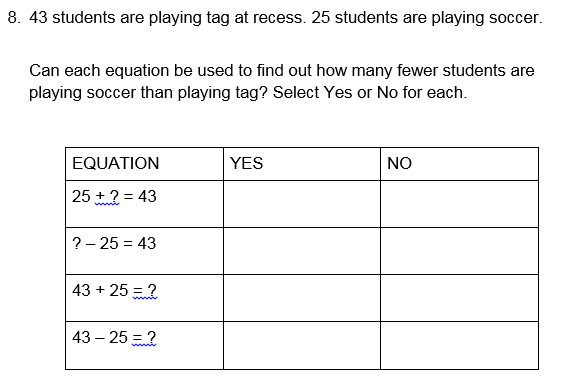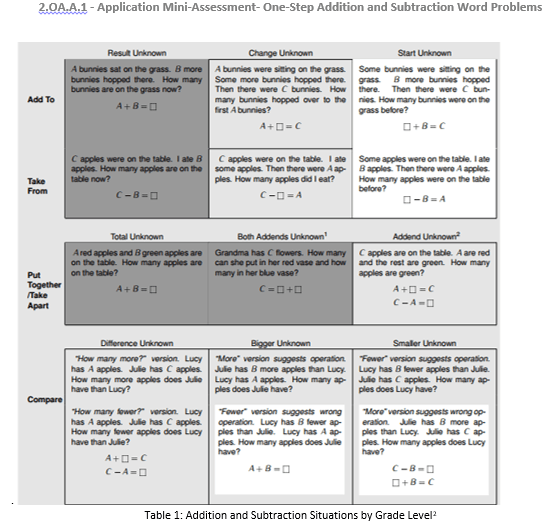In my role as a math coach, I have the opportunity to meet with grade-level teams for a half day about once every 6 weeks. At a recent meeting with kindergarten, grade 1, and grade 2 teams, we examined the Representing and Solving Addition and Subtraction Problems Mini-Assessment. Through my classroom observations at these levels, I noticed that students were struggling when given a story problem in one of the more challenging formats. Using a mini-assessment to structure our discussion would allow us to see the variety of problem types expected by the Common Core State Standards in one concise document. Here’s how I used mini assessments with my teams:
Step 1: Take the assessment
To begin, we took the assessment ourselves independently. This alone posed some challenges! Many of the problems are tricky–not because they were written to be so, but because the story problem takes a some thought and because the response formats are different than what teachers or curricula regularly ask. For example, in Problem 6, information is presented in an order that can be confusing to students.
- Molly’s class has 3 fewer students than Sam’s class. Molly’s class has 25 students.
In Problem 13, students are asked to think about equations that could be used to solve the problem, not to directly answer the question posed in the story problem.
- Which equation can you use to find the number of students in the other class?
16 – ____ = 28
16 +____ = 28
16 – 28 =____
16 + 28 =____
There were teachers in each group who were brave enough to admit they answered a couple of the problems incorrectly. This led to an engaging and fascinating conversation that included several “a-ha moments,” specifically around examining the problem types and the task structures in the mini-assessment.
Step 2: Learn about different problem types
After we went through the each of the problems and shared our solutions, we identified which problem on the mini-assessment was an example of which problem type. Table 1, in the introductory information for the mini-assessment, helped the teachers analyze the problem types. The teachers engaged in this activity were not novices and frequently engage in collaborative mathematical conversations. Still, it took intense collaborative thinking and problem solving to agree on a label for each problem. Although page 2 of the mini assessment also has an answer key to identify each problem type, teachers did not have access to that part of the page at this point in the process.
We discussed the difference between Add to/Take From and Put Together/Take Apart problems. Students approach the modeling of these problems differently so it is important to distinguish them for teachers. Add To/Take From problems involve some type of action: bunnies hopping to or from the yard, frogs jumping in or out of the pond, cookies are eaten, and so on. They differ from Put Together/Take Apart problems. In Put Together/Take Apart problems, two (or more) categories exist: blue and red flowers for example.
A good amount of time was spent analyzing the Compare problems (problems 6, 8, 9, 12, 14, 15). Compare problems are those in which quantities are compared, rather than joined or separated. For younger students, the structure of Compare problems can be confusing. It can be challenging for students to identify which is the larger quantity, which is the smaller quantity, and their relationship (the difference). The phrasing of Compare problems makes the problem tougher–sometimes information is not presented chronologically, which can be puzzling. Teachers lamented that often students simply add the quantities without understanding. Maybe you’ve seen that before? Removing the numbers from the problem in the first read-through helped focus thinking on the relationships in each problem.
Step 3: Analyze task structure
Teachers also noticed and commented on the structure of the problems. Some problems ask for an answer, as one would expect, either in a multiple choice or constructed response format. However, others never ask for an answer to the problem itself. Instead they push students to think about the solution process rather than the result.
 Example of a problem asking students to think about different solution methods.
Example of a problem asking students to think about different solution methods.
In the example above, students must identify all the possible solution equations that might be appropriate to the problem. It was surprising to see these types of response formats in the mini-assessment. One teacher said, “Students must shift their thinking from how they alone might solve the problem to how others might also solve the problem –that’s really difficult!” Simply looking at the structure of the task opened teachers’ eyes to alternatives to how they might ask students to respond to word problems in their own classrooms and how that could deepen students’ understanding.
The value of this experience cannot be underestimated. Coaches, try working through one of the mini-assessments with a teacher team! Teachers, don’t let not having access to a coach stop you! Gather your grade-level or grade-band colleagues and work through the mini-assessment together. There is a lot to learn from the mini-assessments that will carry over into your daily classroom practice.
To see the mini-assessment discussed in this post, and others for grades 2-12, visit Achieve the Core.
















